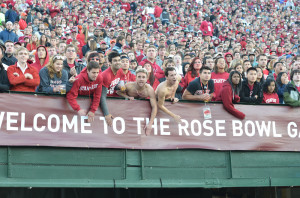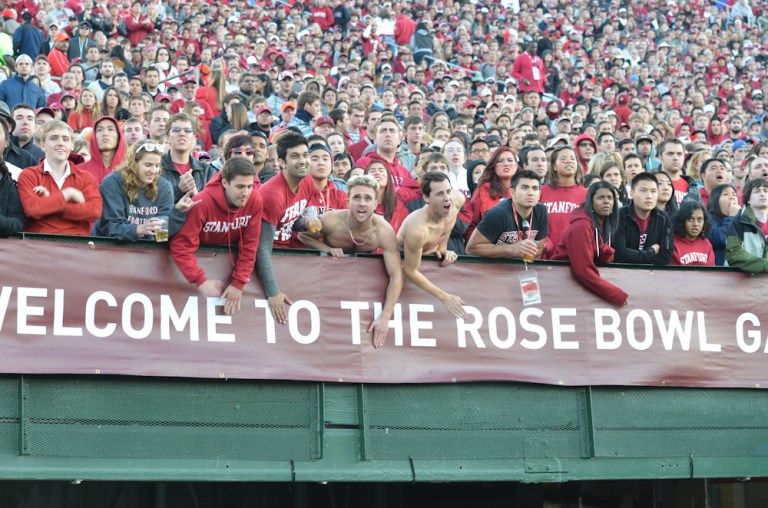Although many college football programs have recently incurred heavy financial losses due to bowl game participation, the Stanford athletics department has seen both an increase in season-ticket renewals and national profile in the aftermath of the 2013 Rose Bowl.

On Feb. 8, the first day that previous season-ticket holders could request seats for the 2013 season, 1,048 seats were renewed, compared to 776 on the same day a year ago — an increase of 35 percent — and 572 in 2011. As of Feb. 14, 2,586 of 25,500 season tickets had been renewed with almost two months remaining before the April 8 deadline.
In recent seasons, football programs across the country have reported millions of dollars in losses based on bowl participation. Virginia Tech reportedly lost $1.6 million in the 2011 Orange Bowl and $2.2 million on the 2009 Orange Bowl, the University of Connecticut reportedly lost close to $1.8 million for playing in the 2011 Fiesta Bowl and even Alabama, the 2010 national champions, reported a $1.8 million loss after the 2010 title game.
As a private institution, Stanford is not required to release its full financial information, but Stanford administrators said that the athletic department met its goal of breaking even on its trip to the 2013 Rose Bowl and is currently reaping the benefits of the increased exposure.
“The bowl game is not a money-making enterprise for the schools participating,” said Mike Eubanks ’97 M.S. ’01, assistant athletic director and director of football administration. “If you are the CFO of Stanford athletics, the goal is to be able to meet all of the program’s and the university’s needs at the bowl game, have the best possible experience and to do that while balancing the budget.”
The Pac-12 conference provides the league’s Rose Bowl representative with a fixed budget of $1.5 million to cover the costs of transporting, housing and feeding the university’s contingent of players, coaches, cheerleaders, band members, administrators and staff.
“Everything we wanted to do — every car that has to be driven between functions down there, every bus trip that the team has to make, every meal that we eat, every decoration that is provided — all of those things cost real dollars,” Eubanks said.
According to the athletic department, Stanford managed their expenses effectively, covering all operating costs within the budget provided by the Rose Bowl.
“One way we save money is that we try to operate as efficiently as possible from a staffing perspective,” said Kevin Blue ’05, the associate athletic director for business strategy. “Other institutions make different decisions about how many staff they feel are needed to work to support the operation.”
In 2009, Stanford made its first bowl appearance in eight years at the Sun Bowl. The Cardinal has qualified for a BCS bowl in each of the three seasons since, which Eubanks said taught the department a lot about how to run an efficient bowl operation.
“What we learned from our planning and our budgeting process helped us go in and really avoid the surprises,” Eubanks said. “We understood what was going to pop up and did a great job of trying to keep everything at a zero balanced budget.”
Stanford also avoided significant losses due to high demand for tickets. Bowl participants are contractually obligated to purchase a block of tickets and try to sell them to their fans. Many schools report that the majority of their losses come from absorbing the costs of unsold tickets.
For the 2013 Rose Bowl, Stanford fans bought all of the 30,193 tickets allocated to Stanford in less than 24 hours. The athletic department ultimately acquired and sold approximately 8,000 more tickets. However, Stanford did not earn supplemental revenue from selling additional tickets, since all ticket income goes back to the bowl organizers.
“The revenue from those tickets went to the Rose Bowl,” Eubanks said. “We were selling the Rose Bowl’s tickets and providing an additional service to our fans, our alumni and our students by being able to meet their demand and so that they would be able to sit in Stanford’s section.”
According to Roger Noll, a professor emeritus of economics who has done research on the economics of intercollegiate athletics, there is very little direct financial incentive for schools to participate in bowl games, with most benefits emerging only over time.
“Schools expect that it will increase ticket sales for the next year and that it will increase their ability to recruit,” Noll said. “The hope is that the publicity associated with it will be helpful.”
University officials said that, while the monetary impact can be hard to quantify, winning the Rose Bowl certainly created excitement among the fan base and likely prompted a more active donor base.
“There’s no question that the financial support [from alumni and donors] that the athletic department and the university receives is stirred up by Stanford playing in and winning the Rose Bowl game,” Eubanks said. “People are excited and want to reward a job that is well done, and there can be no job that is done better than winning a Rose Bowl.”
Noll said that for schools that have built their reputation on strong academics, the benefits of increased exposure are likely less than they would otherwise be.
“Stanford is not exactly your standard football factory,” Noll said. “For schools like Stanford, Northwestern and Duke, which have high-quality undergraduates and many times as many applicants as they have students, there’s not a whole lot of additional publicity value because that’s not the main reason to go there.”
According to Jon Denney ’85, senior associate vice president for development, it is difficult to link increased giving to any specific event. He noted, however, that the success of the football program can help alumni feel more connected and engaged with the university.
The athletic department also expressed optimism that the Rose Bowl win will lead to increased interest in the football team next season. Last season, Stanford’s average attendance for home games was 43,343 people — worse than that of all Pac-12 teams except Washington State.
Besides increased interest in season ticket renewals, the athletic department reported high interest in new season-ticket sales as well.
According to Blue, the university had received deposits for 1,256 new season ticket accounts as of Feb. 14. The athletic department reports that on average, each account purchases 2.7 seats, which means that Stanford has already seen interest in close to 3,200 new season-ticket holders with seven months to go before the season starts.
“Those signs, although very, very early and nascent, are pointing in a very positive direction for what 2013 ticket sales and attendance will be,” Eubanks said. “That will have a significant financial impact on us.”
“Winning the Pac-12 championship and playing the Rose Bowl and winning the Rose Bowl game has a direct impact on fan interest,” Eubanks said. “There is no doubt that the excitement and level of interest leading into the 2013 season is heightened as a result of playing in and winning the Rose Bowl.”
